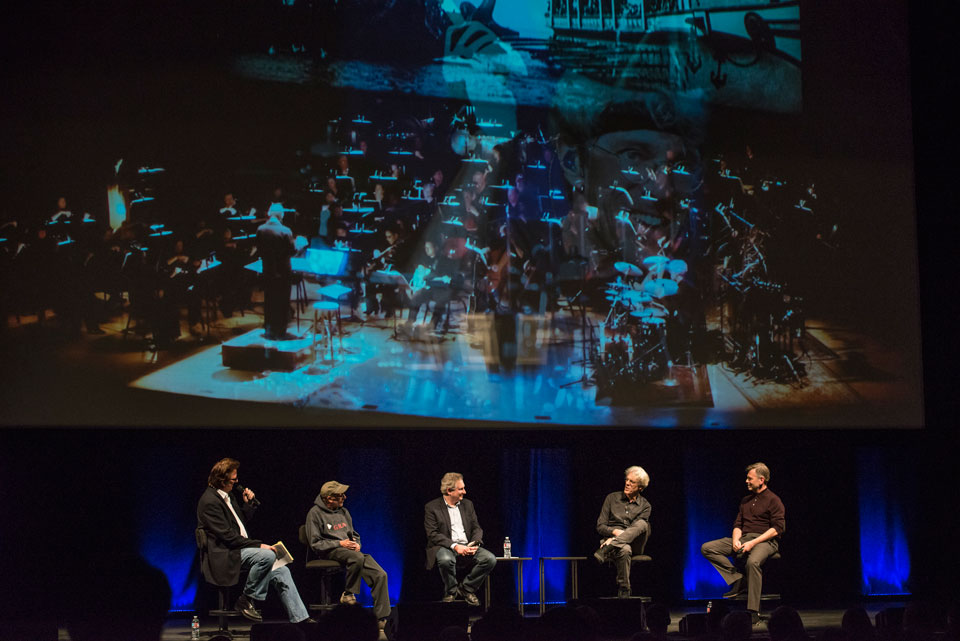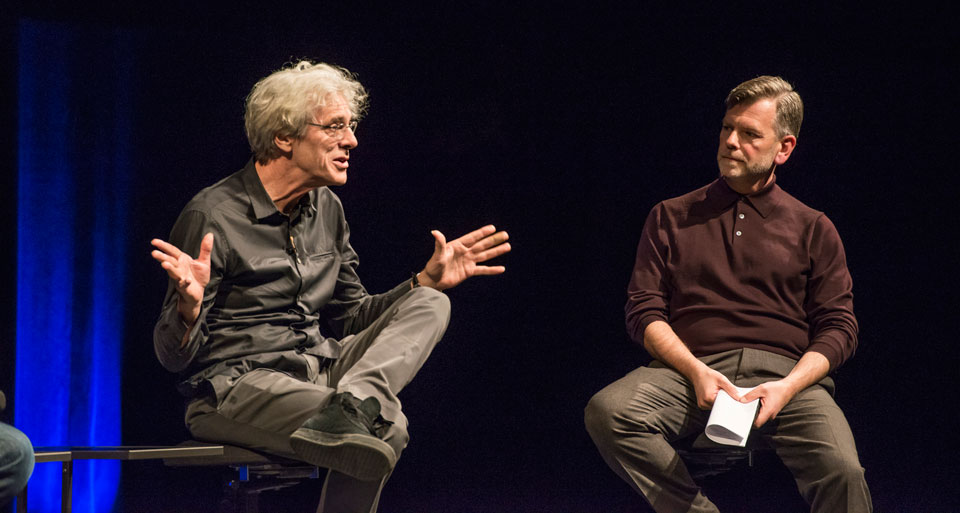Stewart Copeland Drums Up Score for 1925 Silent Film Classic, Ben-Hur: A Tale of the Christ
It’s fitting that music filled the earliest childhood memories for Rock and Roll Hall of Famer Stewart Copeland, who shared some of those recollections on March 7 on the main stage at California State University, Northridge’s Valley Performing Arts Center.
Participating in a question-and-answer session on the same stage where he will perform his score for the classic 1925 silent film Ben-Hur: A Tale of the Christ on March 16, Copeland early on spoke about the conflict that he experienced.
His father was a jazz trumpeter, and passed along the genre to his son, “which really cured me of the stuff,” Copeland quipped, laughter ringing from the VPAC audience.
His mother surrounded him with classical music, especially Ravel and Stravinsky. Then he discovered one of the early drumming legends, Buddy Rich. “I can say that I’m classically trained on the drums, which is a ridiculous statement,” Copeland said.
Then he joined the revolution that was 1960s rock ’n roll, which set the young drummer on that path that would end up with his becoming the founding member of The Police, the iconic trio with fellow bandmates Sting and CSUN alumnus Andy Summers ’72 (Music). While the band set a musical course on its way to being inducted into the Rock and Roll Hall of Fame in 2003, its musical roots were an incredible combination of punk and classical influences.
“Along came punk, which is a whole new hairdo,” Copeland said. “Louder, faster music, for a louder, faster person. We were a fake punk band, because we were very proficient on our instruments.”
That “fake punk band” set the world ablaze from the time the single “Roxanne” began lighting up the radio airwaves in 1978, through the multi-platinum success of the album Synchronicity in 1983. Even before the band members went their separate ways in 1985, Copeland discovered a new musical passion, almost by accident.
Copeland was asked by Oscar-winning director Francis Ford Coppola to compose the score for the movie Rumble Fish in 1983. Although he’d never done anything like that before, he took on the challenge and eventually hit the right notes.
“It’s kind of a cool thing,” Copeland said. “If you don’t know what you’re doing and you have to make it up, chances are you’re going to end up inventing the wheel very differently from all the professionals.”
Several years ago he looked into adding the score for the original Ben-Hur, which inspired the 1959 classic that received 11 Academy Awards, including Best Picture. Copeland recalled for the audience how at first he didn’t know who to speak with at MGM – the studio that released the original film – to gain the rights to add the score to the movie and eventually create the orchestral production that will grace the VPAC stage, accompanied by the Pacific Symphony and conducted by CSUN alumnus Richard Kaufman ’77 (Music).
Copeland talked about how adding music to this silent film added so many elements for the audience, even though it was cut down from a run time of 140 minutes to 90 minutes. The music was created to blend with the facial expressions and the extreme action throughout the Fred Niblo-directed film, which at the time set the record for the highest budget for a film at $4 million.
“It’s the story of Jesus Christ, hence the title of the book, Ben Hur: A Tale of the Christ,” Copeland added. “It’s the Bible, but with a really cool pirate ship, with a really cool chariot race, with all kinds of swords and sandals, but all the message and mission of the Christ.”
Copeland talked about how he wrote the score for the movie using a computer program that created the sounds from the multitude of instruments. The entire score ended up filling 500 pages of music. “When I carry it I feel like a musician,” Copeland said.
The Police drummer described the difference between the man who sat at the drum kit behind one of the biggest bands in the world in the eye of storm of a stadium packed with 50,000 people, and the composer who writes music to be performed by an orchestra of virtuoso performers acting simultaneously in its own form of synchronicity.
“There are two kinds of musicians,” Copeland explained. “There’s the musician of the eye and musician of the ear. The musician of the ear, they stare off into space and get into that groove, that’s rock bands. Musicians of the eye, the orchestra players, they connect with the music not with their ear, but with their eye. Every note they play, they read from left to right on the page. It’s a very different part of the brain that’s processing music.”
Copeland will embody both types of musician during the VPAC Ben-Hurperformance, as he will pound the drums in time with the Pacific Symphony Orchestra. All the while the movie will add to the spectacle, creating a unique feast for the senses.
“This is a concert, and it’s billed as a concert. But it turns into the movie,” Copeland said.
For more information about the performance, please visit the VPAC website at valleyperformingartscenter.org. Discounts are available for CSUN students.



 experience
experience